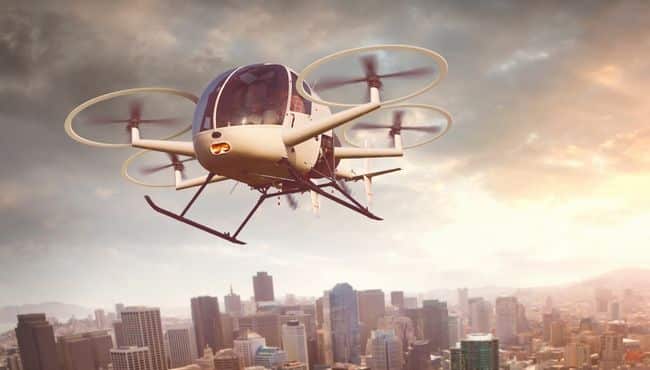One of the most exciting developments in drone technology is the increasing possibility that people will be able to travel via taxi or passenger drones in the near future. This mode of urban air travel is already being tested in a few cities around the world, and the trials so far have been positive. In this blog post, we’ll take a closer look at drone taxis and how they could revolutionise urban air mobility. We’ll also discuss the benefits of drone taxis, their potential safety concerns, and the different companies working on this exciting new technology. Read on to learn more!
What Is A Taxi Drone?
A taxi or passenger drone is a type of aerial vehicle that can be manned or unmanned, and they are designed to transport civilians living in urban areas for short to medium-range journeys.
These drones are also known as electric vertical take-off and landing vehicles or eVTOL for short and come in different shapes and sizes.
They are fully electric which means they require no fossil fuel and have zero emissions and come equipped with the latest in advanced flight technology that allows for safer, quicker, and fully autonomous journeys.
Most of the eVTOL drones that are currently being tested have either a fixed-wing propulsion system or multiple radial propulsion systems the latter of which is similar in design to a helicopter. The fixed-wing eVTOL drones have a vectored thrust design, which allows for their vertical take-off and landing capability. These drones are usually larger and can carry more passengers.
Taxi drones are lighter, quieter, and faster than traditional methods of urban transportation and they will play an important role in the future of smart cities.
Benefits Of Taxi Drones
As with any type of disruptive technology, there are benefits as well as some drawbacks to eVTOL taxi drones.
The benefits of eVTOL taxi drones are many but the main one is the elimination of fossil fuels to power these aircraft.
Fully electric vehicles like taxi drones are the future of transportation, they have many advantages over vehicles that require fossil fuels and one of the main ones is zero greenhouse gas emissions.
Zero net emissions is something many companies are aiming towards, this helps protect the environment from pollution and aids in the fight against climate change.
With no CO2 emission, this will help reduce air pollution which means cleaner air and will also help improve people’s health. Another benefit of electric vehicles is lower operating and maintenance costs.
Many Governments around the world are also encouraging the use of electric vehicles through incentives and I am certain there will be similar incentives for people to use taxi drones.
Another benefit of taxi drones is no congestion and free air space, taxi drones are able to complete a journey much faster than cars, buses, trams, etc. According to this article, a 2-hour journey with a car could be cut down to just 30 minutes with an eVTOL drone.
For example, The video below shows a test flight of Joby Aviation’s eVTOL drone, the video highlights that the drone can make a 151-mile journey from San Francisco to Lake Tahoe in just over an hour. While a car has to journey a much longer route of 183 miles with a time of just over 2hrs and 30 minutes.
As electric vehicles are cheaper to operate, this may also mean reasonable fares, although we don’t know how much a routine journey will cost, there are a few estimates from some of the leading eVTOL companies.
For example, according to Flyingmag, companies like Lilium, Archer Aviation, and Eve Urban Air Mobil estimate that a one-mile journey for 1 passenger may cost anything between $2.25 -$3.88, while Nasa estimates a higher price per mile journey of $6-$11.
While these fares are much higher than traditional taxi services, they are the initial starting estimates and according to Uber (who have since sold their Air Taxi department to Joby Aviation), they predict that as the service matures, many companies will hope to reduce the overall cost of drone taxi fares so that it is affordable for everyone.
Taxi Drone Companies
The urban air mobility market is a multibillion-dollar industry and forecasts suggest that it could be worth around $28 billion by 2030.
There is huge potential for this market to explode within the next decade and this potential is reflected in the number of companies that have started investing in this technology which is currently around 200.
Although a lot of these companies will not survive, there are a handful of ones that have developed a number of prototype models that have been trialed and are close to opening up limited services within the next few years.
Ehang
Established in 2014, Ehang is one of the leading manufacturers of autonomous aerial vehicles (AAV) for passengers, logistics, and for emergency services.
The Ehang 216 is a fully autonomous aerial vehicle that can transport 2 passengers over a range of 30km and has a maximum flight time of around 25 minutes. The drone comes with a full redundancy system and is monitored and controlled by a central command center.
Ehang has successfully carried out over 1000 test flights with the 216 AAV and has received pre-orders from companies in Indonesia, Malaysia, Thailand, Japan, and Canada.
The company is well funded having received $149 million from China’s third-largest bank earlier this year.
In addition to passenger transport, the Ehang 216 is also used for logistics operations and some of them have been modified for emergency services such as fighting fires in high-rise buildings.
Volocopter
Along with Ehang, Volocopter is in the advanced stages of offering drone taxi services in a limited capacity.
Volocopter has over 10 years of experience in the aerospace industry and is one of the leaders in eVTOL technology.
They have developed two types of eVTOL drones for air taxi services, the VoloCity and VoloConnect. The VoloCity is a multi-rotor vehicle and is for short-distance journeys while the VoloConnect is a fixed-wing drone with a vectored thrust design that has been developed for longer journeys.
Volocopter also has a drone for logistical use called the VoloDrone that has been used for drone delivery.
According to Bloomberg, VoloCopter hopes to start offering limited air taxi services in Singapore within two years, although, how feasible this remains to be seen.
They are a well-funded company that have raised nearly $600 million since 2013 and has a valuation of $1.7b.
Lillium
Founded in 2015, Lilium has big ideas that will revolutionise urban air mobility, their current eVTOL vehicle has some innovative design features that provides it with better aerodynamic efficiency, improved payload capacity, and reduced noise pollution.
The Lilium Jet can be configured to carry between 4-6 passengers and has a range of 190km. In 2021, the Chief technology officer released a detailed blog post about their vision, the innovative technology that underlines their aircraft, and their plans for a 7-seater jet.
Although the company is very well-funded, having raised over $800 million since its founding, the company has not shared any data about the Jets flight test and has yet to produce any kind of public road map.
Joby Aviation
Joby Aviation was founded in 2009 and has been researching and developing al aspects of electric aerial aviation.
The eVTOL vehicle from Joby Aviation has been 10 years in the making, after years of secretive testing, they finally decided to release details about their aircraft and financials in 2020.
The aircraft has 6 electric motors, comes with a range of 150 miles, and a top speed of 200 mph. Test flights have shown that the aircraft can complete 150 miles in just over an hour and it can carry 4 passengers plus a pilot.
Although Joby has not indicated when they expect to start a limited service (like Ehang & Volocopter), they do have some major investors like Toyota, Intel, and Uber, so their immediate future looks stable.
Challenges Of Taxi Drones & Urban Air Mobility
Of course, while the benefits are numerous, there are many challenges that must be overcome before taxi drones can be as ubiquitous as cars.
The technology is still very new and although polls suggest people are excited about this new mode of transportation, there are concerns about safety and cost.
According to flyingmag.com, there are 4 main challenges facing urban air mobility, they are infrastructure, technology, regulations, and public acceptance.
Infrastructure is probably the biggest challenge for urban air mobility, while some eVTOL will be able to take off and land on existing helipads, in the long term, new sustainable infrastructure will be vital for the success of UAM.
There are plans by the likes of Volocopter and Joby to build their own vertiports in partnership with SkyPorts which are one of the leading providers of infrastructure solutions for advanced air mobility vehicles.
VoloCopter and SkyPorts have already built a prototype vertiport in Singapore and have plans to build more as and when VoloCopter expands into more areas.
Of course, building more vertiports and getting eVTOL vehicles in the sky will depend on regulatory approval from the likes of the FAA, CAA, and EASA.
The EASA has provided some guidance regarding eVTOL specifications and how they should be operated safely in low-altitude air space. However, the FAA and CAA have not provided any guidelines yet, they HAVE released a joint statement in which they urged companies to use existing regulatory frameworks on building, operating, and maintaining eVTOL drones.
As this is a new and fast-moving technology, regulators like the FAA and CAA are watching how the eVTOL and UAM industry unfolds before committing to a set of regulations for companies to follow.
According to the FAA, One reason for this delay is because of their experience with regulating commercial drones which have needed to be constantly updated as the technology evolves.
There is also the issue of air traffic management for UAM, regulators and industry leaders will need to work together to formulate protocols that will ensure the safe passage of multiple low-altitude manned and unmanned aircraft.
Final Thoughts
The use of drones as taxis is one of the most exciting areas of urban air mobility, while we are probably a decade away from seeing them being widely adopted in all the major cities, there is no doubt about their benefits. These benefits include faster journey times, zero congestion, and the elimination of fossil fuels which will result in reduced air pollution and cleaner air. There are of course some major challenges as we have outlined in this article which will need to be overcome If this exciting mode of transportation is to be fully realised. We shall get a good idea on how far this technology can go as the likes of Volocopter and Ehang start trialing their vehicles in larger areas in the next couple of years.


